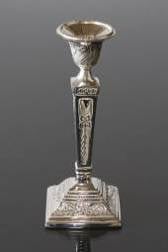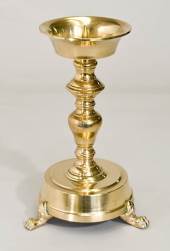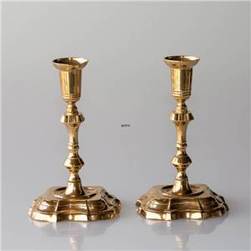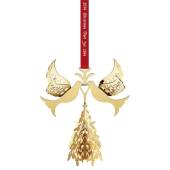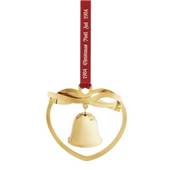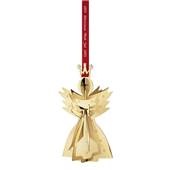Silverware, copperware, bronze, and brass are popular again
It has become popular to set a table with silverware, copperware, bronze, and brass again. It has long been the smooth right lined designer look that have been in, but now the time has come to give the table some personality and presence with decorated metal objects. This provides the room with a more cozy feel and adds some patina to the room.
But when the silverware and copperware is brought back to the table the challenges surrounding its maintenance arise. We would like to assist in making this process easier with some good advice concerning you metal items.
Metals are attacked by the oxygen that surrounds us and it is this, which causes the discolored surface that needs polishing. A layer of metal oxides are formed on the surface of the metal, where the oxygen and metal fuse.
Continued use and the following basic cleaning prevents a large layer of oxidized metal from forming on the surface and thus keeps your cutlery etc. nice and shiny.
Daily Use Keeps Your Silverware Etc. Attractive!
The first advice is in essence a preventive advice. The best way to keep your silverware etc. nice and shiny is to not allow it to need become in need of cleaning in the first place. For metal objects in general it holds that the lack of use increases the need for cleaning as it is the air around us, which makes it flat and dull. So use your silverware continuously and it will stay shiny.
Old plated silverware, copperware, brass and bronze can be bought at very reasonable prices nowadays and it is not expensive to buy. Our advice thus to not just use it for festive occasions but for everyday use, too.
Store the Silverware as Oxygen-free as possible
Our second tip is also about prevention. As it is oxygen that tarnishes the metals, the tarnishing is prevented by reducing the contact with oxygen. This can be done by packing the silverware in freezer bags. First pack it in either acid-free silk paper or in newly washed cotton cloth to protect from the materials in the plastic that might tarnish. Afterwards put the silverware in the freezer bag and close it tightly. Thus the contact with oxygen has been reduced. If you follow the above advices to use the silverware often it is not necessary to keep the silverware in this time-consuming fashion as it does not tarnish much when in constant use.
Another sinner in the tarnishing of silverware is hydrogen sulfide and sulfur dioxide. This can prevented by having a small bowl with activated coal next to the silverware. The activated coal reacts with the sulfur compounds and thus protects the silverware. Activated coal can be bought as granules at the drugstore.
If the silverware has already tarnished?
Prevention is only part of the equation. If the silverware is already tarnished, it is too late to prevent it. Then you will have the clean it. Here are a couple of different methods for various metals and alloys. If you want to clean silver or copper, which are both precious metals and not alloys, then chemical reduction is an easy solution. Be aware that plated silverware should not be cleaned in this manner.
Reduction with aluminum foil
To clean metals by reduction is more simple than the name suggests, there are a number of different methods depending on temper and how fast you wish the process to proceed. What you will need for all methods are a washtub that you clad with aluminum foil on the inside, boiling water enough to cover the silverware or copperware in the washtub and some cloth to dry it with. All method work best when there is no overlap of the items. They should all lie unobstructed in the water.
The first method only needs normal table salt. You simply pour the boiling water into the washtub with aluminum foil and add a couple of teaspoons of salt. Then stir up the salt in the water with a spoon. Then you put the silverware or copperware in and leave it for two to ten minutes. Then remove it from the washtub and wash it under running water with dish soap and dry it with the cloth. Then the tarnish should be gone. The treatment can be repeated depending on how tarnished the metal is.
The second method includes washing soda (sodium carbonate not caustic soda). Pour in a couple of teaspoons of soda in the boiling water like in the first method and put the items in. Leave them for a couple of minutes and then remove them (use pliers if necessary). Finish of in the same way as in the first method.
The third method includes baking soda (sodium bicarbonate), salt and white vinegar. First pour in a teaspoon of salt and a teaspoon of baking soda into the washtub and then carefully add half a cup of white vinegar. Be careful there will be a small reaction. You can do this without the white vinegar, but it makes the method much quicker. Then pour the boiling water in and put the silverware in. It should only take about half a minute, but if it is badly tarnished you can leave it a little longer. Then use pliers to remove then silverware again. Finish in the same way as in the first method.
These methods are easy and fast, but be aware that all oxidized areas will be removed, which include any patina and darkened areas around patterns that give the silverware character.
Copper, Brass and Bronze
Metals and alloys like copper, brass and bronze do not tarnish to the same extent as silver. Copper can be cleaned by reduction, but it might not be necessary. It will often be enough to just cover the items in soft soap and leave it for a while, then simply wash it in lukewarm water. If this is not enough you can use reduction on the copper, but it will be necessary to polish the brass and bronze.
Polishing
There is no way around it, sometimes it is necessary to polish. For lightly tarnished silver, copper, bronze and brass you can use bistro cleaning paste for either silver or copper/brass from Sterling. If it is strongly tarnished it will be necessary to use a stronger cleaning polish like Brasso. You should choose a liquid polish rather than a powder, since the powder might cause abrasion damage. If it is silverware with filigree or engravings the polishing should be done with care not to damage these.
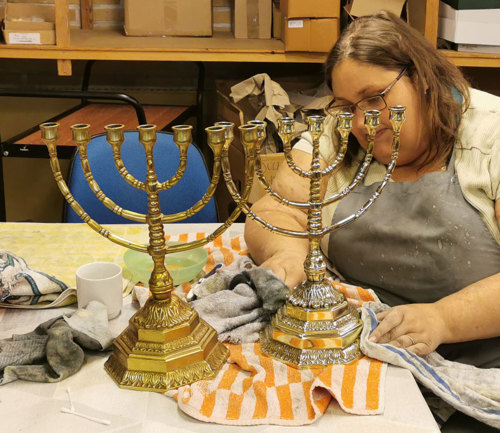
Cleaning where it is not tarnish
Metal items do not only become tarnished. They can also simply not be clean. In those cases then they should merely be washed like any other item. There are some items, where it is not easy to get in and clean all the edges. A good example could be the many beautiful Christmas ornaments and other decorative items from Georg Jensen. In case there are dirt in difficult to reach places or the ornament has become a little dull, you should fill a washtub halfway up with boiling water and add a teaspoon of citric acid and a dash of dish soap. Then place the ornaments in the water and leave them for a couple of minutes, then remove them and dry them. Then they will shine beautifully again. The citric acid method can also be used to make other metal items shiny.
Now there should be nothing stopping you from retrieving the beautiful old silverware and copperware and remember to use it, then it will stay untarnished.
Disclaimer: We accept no liability or responsibility to any person or organization as a consequence of any reliance upon the information contained in this site.
Don't miss free tips and a lot of great sales
DPH Trading
Løkkegravene 49
5270 Odense N, Denmark
CVR-no.: DK61086013
Follow us on social media:

 We are e-approved
We are e-approved


